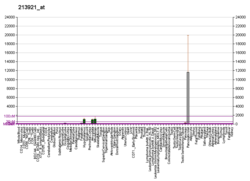
Back سوماتوستاتين Arabic Соматостатин Bulgarian সোমাটোস্টাটিন Bengali/Bangla Somatostatin BS Somatostatina Catalan Somatostatin Czech SST Welsh Somatostatin Danish Somatostatin German ސޯމަޓަސްޓެޓިން DV
Somatostatin, also known as growth hormone-inhibiting hormone (GHIH) or by several other names, is a peptide hormone that regulates the endocrine system and affects neurotransmission and cell proliferation via interaction with G protein-coupled somatostatin receptors and inhibition of the release of numerous secondary hormones. Somatostatin inhibits insulin and glucagon secretion.[5][6]
Somatostatin has two active forms produced by the alternative cleavage of a single preproprotein: one consisting of 14 amino acids (shown in infobox to right), the other consisting of 28 amino acids.[7][8]
Among the vertebrates, there exist six different somatostatin genes that have been named: SS1, SS2, SS3, SS4, SS5 and SS6.[9] Zebrafish have all six.[9] The six different genes, along with the five different somatostatin receptors, allow somatostatin to possess a large range of functions.[10] Humans have only one somatostatin gene, SST.[11][12][13]
- ^ a b c GRCh38: Ensembl release 89: ENSG00000157005 – Ensembl, May 2017
- ^ a b c GRCm38: Ensembl release 89: ENSMUSG00000004366 – Ensembl, May 2017
- ^ "Human PubMed Reference:". National Center for Biotechnology Information, U.S. National Library of Medicine.
- ^ "Mouse PubMed Reference:". National Center for Biotechnology Information, U.S. National Library of Medicine.
- ^ "somatostatin". Encyclopædia Britannica. Encyclopædia Britannica Online. Encyclopædia Britannica Inc., 2016. Web. 04 mag. 2016 <http://www.britannica.com/science/somatostatin>.
- ^ Nelson DL, Cox M, Hoskins AA (2021). Lehninger Principles of Biochemistry (Eighth ed.). New York, NY: Macmillan Learning. ISBN 978-1-319-22800-2. OCLC 1243000176.
The binding of somatostatin to its receptor in the pancreas leads to activation of an inhibitory G protein, or Gi, structurally homologous to Gs, that inhibits adenylyl cyclase and lowers [cAMP]. In this way, somatostatin inhibits the secretion of several hormones, including glucagon
- ^ Costoff A. "Sect. 5, Ch. 4: Structure, Synthesis, and Secretion of Somatostatin". Endocrinology: The Endocrine Pancreas. Medical College of Georgia. p. 16. Archived from the original on April 5, 2008. Retrieved 2008-02-19.
- ^ "somatostatin preproprotein [Homo sapiens]". NCBI Reference Sequence. National Center for Biotechnology Information Support Center (NCBI).
- ^ a b Liu Y, Lu D, Zhang Y, Li S, Liu X, Lin H (September 2010). "The evolution of somatostatin in vertebrates". Gene. 463 (1–2): 21–8. doi:10.1016/j.gene.2010.04.016. PMID 20472043.
- ^ Gahete MD, Cordoba-Chacón J, Duran-Prado M, Malagón MM, Martinez-Fuentes AJ, Gracia-Navarro F, et al. (July 2010). "Somatostatin and its receptors from fish to mammals". Annals of the New York Academy of Sciences. 1200 (1): 43–52. Bibcode:2010NYASA1200...43G. doi:10.1111/j.1749-6632.2010.05511.x. PMID 20633132. S2CID 23346102.
- ^ "Entrez Gene: Somatostatin".
- ^ Shen LP, Pictet RL, Rutter WJ (August 1982). "Human somatostatin I: sequence of the cDNA". Proceedings of the National Academy of Sciences of the United States of America. 79 (15): 4575–9. Bibcode:1982PNAS...79.4575S. doi:10.1073/pnas.79.15.4575. PMC 346717. PMID 6126875.
- ^ Shen LP, Rutter WJ (April 1984). "Sequence of the human somatostatin I gene". Science. 224 (4645): 168–71. Bibcode:1984Sci...224..168S. doi:10.1126/science.6142531. PMID 6142531.




